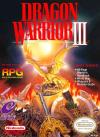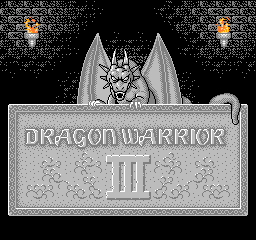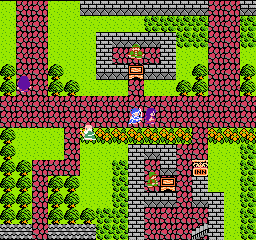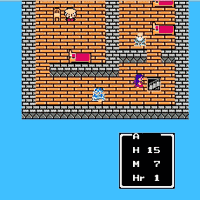Forum Links
Thread Information
Thread Actions
Dragon Warrior 3: the best up to VI
10-03-15 11:18 AM
janus is Offline
| ID: 1207131 | 1860 Words
SecureYourCodeDavid
POSTS: 1885/4811
POST EXP: 565163
LVL EXP: 22942839
CP: 63648.9
VIZ: 556153

After The torture of Dragon Warrior I, after The better Dragon Warrior II, here is Dragon Warrior III, The best of The old-gen Dragon Warriors. Why? You will see… NOTE THAT THIS REVIEW CONTAINS MAJOR SPOILERS ABOUT THE GAME, AS THEY ARE PART OF WHY I LIKED THE GAME. YOU HAVE BEEN WARNED Graphics: 9/10 The graphics are really impressive for The NES. Launched in 1989 in Japan, it is advantageously comparable to Final Fantasy III, launched at about The same time (unlike DW II / FF II). With respect to Dragon Warrior II, The graphics are even more impressive. The characters are drawn better (although they still look like obese midgets), with their clothes and armors (especially for The main hero) being more finely visible. And they are quite varied, depending on The class you give them. There was a neat attention given to towns too. Bricks come in all sorts of shapes and patterns, bushes and trees and now obstacles you can’t walk on (which can be annoying; see difficulty section) and villagers are also varied. The game introduces (unlike nearly all RPGs, even on The PSX) The concept of night, which is crucial to advance in your quest – you will only be able to get special objects or clues about them at night. Fortunately there is an accessory (Lamp of Darkness) which helps changing to night quickly, and a spell for your wizard to switch day and night. Little inconsistency though: where you warp to another town and it’s night, it automatically turns to day… In addition, castles are now GIGANTIC. So much that, once inside a village, you actually have to enter The castle icon proper to be inside. The overworld map has been neatly designed and comes with even more varied land (there is even ice). Also The shape of The world is… peculiar. If you look at it and look where places like Romali, Portoga, Jipang, The Pyramid, Greenlad and Eginbear are, you will see that it is quite original. Speaking of which, kudos for Jipang and The Pyramid: The former really looked like Japan with its dojo and arks, while The Pyramid had stone statues like The real Pyramids of Egypt. The game also introduces a new concept: The Dark World. It is indeed very dark but it looks… quite familiar for some reason. Dungeons have also been improved. They are larger, come in more varied shapes and are also more confusing. Be sure to notice where every stairs are or you will not be able to get your mission over. Anyway what stroke me was The attention to mere statues you find in several dungeons. Unlike DW II (and even The FFs) they come is many shapes and sizes, even on walls at times. Dungeons also boast stone bridges, which I thought were very finely drawn and structured. Finally, battles have been slightly improved from DW II, but are still inferior to The FFs as you don’t see any movement whatsoever. When The battle starts, you can already see you enemies – they slowly appeared in DW II. Although many of them are still pallet swaps, they nevertheless come in much more diversified forms than DW II. Novelty: you can, for The first time, attack your allies or heal The enemy. *That* might come useful at some point… Two last point: you can see what your allies carry in their “bag” when you Music: 9/10 Along with better graphics, DW III also comes with better music. Although Dragon Warrior IV has a more elaborate soundtrack, III’s is better. Once again it is a neat improvement from DW II. The music takes longer to loop, The arrangements are more complex (especially for dungeons and towers) but also more appropriate. The battle music is The perfect example: when The screen is switching to The battle proper, you see a circle-like pattern, which was use as The intro to The track. Other notable improvements include The castle music (more “regal” and less annoying), The first overworld theme (more epic) and The boat music, which also sounds more epic. Although The NES chip kept it from sounding better, The theme of Jipang was well-done and suited its “Eastern” ambiance with The arks and in dojo. The same thing applies to The Pyramid, which gets as “Arabic” as 8-bits music allows. And then there is The Dark World theme which also sounds… quite familiar. It was better than its 2 previous versions mainly because it sounds more intriguing. Finally, The arrangements for The final battle show a neat evolution from I and II, giving it much more drama. The tempo is much quicker and shows The evolution of NES music. There was no true change for sound effects. They are basically The same as DW II and are not worth your attention. As I said above trees are now an obstacle. So when you hit them it produces a sound. Unfortunately, The sounds happens EVERY time you hit an obstacle, including changing directions in order to talk to a merchant. That was most annoying. Addictiveness: 9/10 One of The main hooking factors in this game is The battle arena, where you bet on monsters combating each other. The slimmer The odds, The more money you get – and it sometimes happens. Of course with savestates winning is assured; you just have to peak at The combat, reload and bid on The right monster. Another hooking factor is The sheer number of sidequests – not strictly necessary to progress – present so early in The game. In The speedrun, The gamer goes directly to The Pyramid right after getting The first key. He therefore skips an incredible amount of quests (save The elf, get The crown back and play as king, wake up The Finally – and that’s why I love The game so much – The fact that this game is a prequel to DW I was enough to get me completely addicted (see depth section). There are not that many games that have such a logical prequel. I dare say it’s even better (on that point) than Lufia II: Rise of The Sinistrals as The ending does imply DW I, in The sense that there are no questions left like, “Where The hell are The other villages?” or “Why are The spells and weaponry so much better in The past?” The world is strictly limited to Alefgard; The map has edges so you can’t circle The world. Story: 10/10 Your father Ortega was a brave hero. He went far off to fight even; he was even able to slay an evil dragon atop a volcano. But unfortunately he fell and wasn’t seen since. The game start with you, The hero / heroin (slight differences in equipment) on your 16th birthday. Your mother bring you to The castle of Aliahan, where The King sends you on a mission to slay The evil Baramos before he destroys The world. All through your quest you will learn a bit more on your mission, but also your own father. As such The story might look clichéd and uninteresting… Depth: 10/10 But it goes WAY beyond that classical kill-The-vilain-trying-to-destroy-The-world narrative. First, as I said, there are so many sidequests for you in order to build your level (and wealth in The monster arena) that you might even get distracted from your main one. Second, The fact that The game is a prequel that loops The loop is certainly The highlight. DW III is as if Phantasy Star I had been place after II and IV, where you would finally see who Alis Landale and Lassic were. I know no other game that have planned they series in such a logical manner. You get to meet Rubiss, see Haukesness when it is still standing and Caitlin, which thinks about building a golem in order to be safer. The ultimate weapons you get will become Erdrick’s gear in I and II. Difficulty: 6/10 This was difficult to rate as there are so many things that both bring The difficulty level up and down. First – I do not know whether it is caused by my keyboard – but controls are hardly responsive. I need to press The directional button for nearly a second to get my characters to change direction (on a boat for example), which means I get on The shore more than I wish to. And when on The option screen/ shopping window controls are TOO responsive, meaning that you might accidentally drop something you wanted to give. Second, The AI in this game is much more advanced. Unlike DW II, you can not avoid a fight unless you heal one step before it happens. Also, when you try to grind your level with metal slimes or babbles, your actions are much more limited if you do not want them to flee – in DW II, you could simply hit The loading button, and that fraction of a second made all The difference in The world. Finally, as with many RPGs, level grinding is essential for your survival. Just before getting outside The island where you first start, you need to be at least level 7-8 before having a realistic shot at The monsters in The cave leading to The next world. It gets worse against many enemies and bosses, who get two rounds of attack. Fortunately, The grinding is made easier because enemies are worth more in experience. Money is still a problem, but you have The monster arena for that. Also, since you can have up to 3 team mates your fights will be easier. Hell, you can even have Sages (using both wizard and pilgrim magic) meaning that you can both heal your party and burn The enemy with The same person. And you can change those characters as often as you want (keeping in mind that they start from level 1, same as a character changing class) Also – at last! – you can deposit unneeded objects (and cash) in a safe! I believe only The Breath of Fire series offered that welcomed option to clear out your (very) limited inventory once you do not need an object anymore (like The prison/magic keys once you get The Final Key). Finally, if you look VERY carefully, there is a way to make The final boss a joke (he becomes vulnerable to healing spells). Just watch for my guide, to be published eventually, to know how. In short, Dragon Warrior is a must-try for anyone who likes RPGs. The graphics and music were impressive for The time, you will surely lose track of time in The monster arena and The story will hook you up, especially if you are a fan of Dragon Warrior. Plus The difficulty level is reasonable. |
YouTube Video Editor
| the unknown |
Affected by 'Laziness Syndrome'
Registered: 12-14-12
Location: Murica
Last Post: 36 days
Last Active: 1 day


 User Notice
User Notice 






